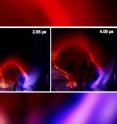It's always sunny in Caltech Lab
In orbit around Earth is a wide range of satellites that we rely on for everything from television and radio feeds to GPS navigation. Although these spacecraft soar high above storms on Earth, they are still vulnerable to weather -- only it's weather from the sun. Large solar flares -- or plasma that erupts from the sun's surface -- can cause widespread damage, both in space and on Earth, which is why researchers at the California Institute of Technology (Caltech) are working to learn more about the possible precursors to solar flares called plasma loops. Now, they have recreated these loops in the lab. "We're studying how these solar loops work, which contributes to the knowledge of space weather," says Paul Bellan, professor of applied physics at Caltech, who compares the research to studying hurricanes. For example, you can't predict a hurricane unless you know more about the events that precede it, like high-pressure and low-pressure fronts. The same is true for solar flares. "It takes some time for the plasma to get to Earth from the sun, so it's possible that with more research, we could have up to a two-day warning period for massive solar flares."
The laboratory plasma loop studies were conducted by graduate student Eve Stenson together with Bellan and are reported in the August 13 issue of the journal Physical Review Letters.
They found that two magnetic forces control the behavior of arching loops of plasma, which is hot, ionized gas. "One force expands the arch radius and so lengthens the loop while the other continuously injects plasma from both ends into the loop," Bellan explains. "This latter force injects just the right amount of plasma to keep the density in the loop constant as it lengthens."
The duo says that in simpler terms, this process is like squeezing toothpaste into a tube from both ends, except that the toothpaste has little magnets in it, so there are magnetic forces acting internally. Stenson and Bellan studied plasma loops that they generated with a pulse-powered, magnetized plasma gun. Inside a vacuum chamber, electromagnets create an arched magnetic field. Then, hydrogen and nitrogen gas is released at the two footpoints of the arch. Finally, a high-voltage electrical current is applied at the footpoints to ionize the gas and turn it into plasma, which travels at a minimum speed of about six miles per second.
"All three steps -- the magnetic field, and the gas, and the high voltage -- happen in just a flash of light inside the chamber," says Stenson. "We use high-speed cameras with optical filters to capture the behavior of the plasmas."
By color-coding the inflowing plasma, the optical filters vividly demonstrated the flow from the two ends of the loop. According to Bellan, no one has ever used this technique before. On camera, red plasma flows into the loop from one footpoint while blue plasma simultaneously flows into the loop from the other end.
"For each experiment, you'll only see the light from the hydrogen side or the nitrogen side in the images," explains Stenson. "But these experiments are very reproducible, so we can put separate images on top of each other to see both plasmas in one picture."
Next, Bellan's lab will test how two loops interact with each other. "We want to see if they can merge and form one big loop," says Bellan. "Some people believe that this is how larger plasma loops on the sun are formed."
Funding for the research outlined in the Physical Review Letters paper, "Magnetically Driven Flows in Arched Plasma Structures," came from the National Science Foundation, the U.S. Department of Energy, and the Air Force Office of Scientific Research.
Source: California Institute of Technology
Other sources
- Sun's plasma loops studied in laboratoryfrom UPIWed, 22 Aug 2012, 21:00:41 UTC
- Sun's plasma loops studied in laboratoryfrom UPIWed, 22 Aug 2012, 20:31:06 UTC
- Sun's plasma loops recreated in the lab to help understand solar physicsfrom Science DailyWed, 22 Aug 2012, 3:30:21 UTC
- Researchers reproduce plasma loops to help understand solar physicsfrom PhysorgTue, 21 Aug 2012, 16:01:33 UTC
- Massive Solar Loop on Sun Captured by Photographerfrom Space.comMon, 20 Aug 2012, 19:30:51 UTC
